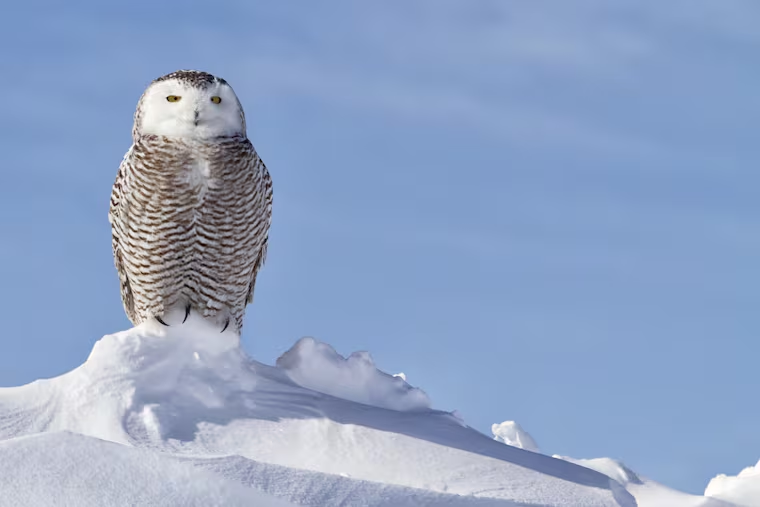Birders go bonkers over a snowy owl in Pa., highlighting the pandemic growing pains and obsessions of the hobby
Normally a resident of the Arctic, snowy owls travel south in the winter to look for food.

The average crow outside your window is a genius compared with an owl.
In the world of birding, however, common birds like crows can’t draw the crowds and even controversy an owl elicits. As the hobby exploded in popularity during the pandemic, owl sightings in Pennsylvania, coupled with social media posts, highlighted how something as simple as birding can get so complicated.
One Facebook birding group went so far as to ban owl photos and reports
“Sometimes people go bonkers over an owl,” said Chad Kauffman, an administrator for PA Birders, a Facebook birding group with 10,000 members. “They just go nuts.”
In February, a snowy owl touched down in a field in Lancaster County. The large owls are native to the Arctic but often travel south in winter to look for food. Most owls are strictly nocturnal. They’re heard more than they’re seen, and in birding, hearing a call is considered a sighting. But snowy owls are diurnal, meaning they will hunt at all hours. That’s why people flock to see them.
An online bird-reporting database created by the Cornell Lab of Ornithology, the proliferation of social media pages dedicated to the outdoors and photography, news reports, and even Harry Potter, who had a pet snowy owl, all contributed to the crowds too. Birders traveled from multiple states to see the owl and some trespassed on private property to get a closer look.
“So this morning my wife and I are in the Lancaster area and I told her I’d swing by and let her see the snowy owl. I was appalled to see the lack of respect for the property owners land today. As birders we need to do better and this is why I refuse to give these locations,” one member of a Facebook birding group wrote on Feb. 11.
That’s nothing compared with what happened in 2017, when a black-backed oriole from central Mexico wound up in Berks County. A study conducted by the University of New South Wales in Australia concluded that 1,824 people from 35 states, along with Canada and the United Kingdom, came to Pennsylvania to see the bird and generated $223,000 into the local economy.
There was also an infamous snowy owl rush in Pennsylvania, in Lancaster, back in 2014.
Most of the problems that arise during snowy owl and other unique bird sightings are addressed by the American Birding Association’s code of ethics, said John Harvey, of the Northeastern Pennsylvania Audubon Society. Among them: Never enter private property without the landowner’s permission.
Kauffman, of PA Birders, has shared specific etiquette rules in his Facebook group from a snowy owl nonprofit. The birds, unused to crowds and traffic, might allow humans to get closer than you’d imagine. That doesn’t mean you should.
“I understand the grandfather who just wants to show his grandson a snowy owl for the first time,” he said.
Harvey said birders can sign up for “rare bird” alerts through eBird, and for some enthusiasts, that’s the main goal. They will hop on planes at a moment’s notice to see a bird few have laid eyes on. Birding, he said, has room for hard-core enthusiasts who want to compete, along with the more photo-oriented who set up expensive cameras and zoom lenses. But the hobby can be as simple as setting up a bird feeder in the backyard or taking a walk on your lunch break.
“Right now, I’m looking at a yellow-bellied sap sucker, a mourning dove, and some sparrows,” Harvey said.
A psychologist from Wayne County, Harvey puts stock in the mindfulness of birding.
“Are you into birding as a contest or the experience of seeing nature and enriching yourself,” he said.
Casual birders could see a crow solving complex problems on their garage roof.
Jason Hall, founder of the Philly-based In Color Birding Club, said a snowy owl situation would be even more complicated for BIPOC birders. They can’t assume they’d simply get a warning for trespassing, he said, and some wouldn’t feel comfortable seeking permission from landowners on rural farms in predominantly white areas
“Black and brown folks are keenly aware of how we’re perceived,” Hall said. “We’re surrounded by people looking at us from a very different perspective.”
The 2020 video of Christian Cooper, a Black birder, and a white dog walker in Central Park made that clear.
Birding, Hall said, can be the most accessible outdoor hobby, though.
“Not everyone can see, or drive, or even walk,” he said. “Whatever way you can enjoy birds, start there.”